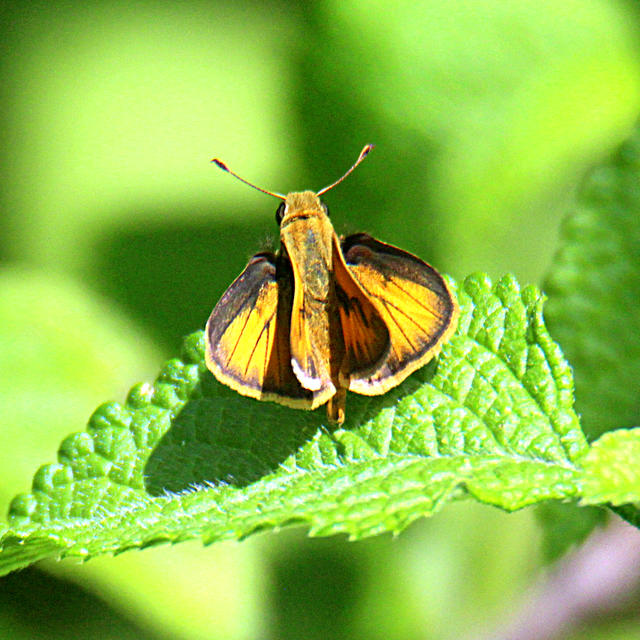Whirlabout
Polites vibex (Geyer, 1832)
Family: Hesperiidae
Subfamily: Hesperiinae
Identification: Males and females are very different. Male Upperside is yellow-orange; forewing has a black stigma and neighboring black square patch; black margins of hindwing are smooth inwardly. Underside is yellow-orange; hindwing has a few large blurred black spots. Female: Upperside is dark brown; forewing has a few clear spots. Underside is gray or sooty yellow with a central pale patch outlined with dark scales.
Wing Span: 1 - 1 1/2 inches (2.5 - 3.9 cm).
Life History: Adult flight is quick and darting. Females are usually found in forest openings or edges; males perch to await females during the afternoon. Caterpillars live in a tube of silked-together leaves and feed mostly at night.
Flight: Two broods from April-September in the north; all year in Florida and South Texas.
Caterpillar Hosts: Grasses including Bermuda grass (Cynodon dactylon), St. Augustine grass (Stenotaphrum secundatum), and thin paspalum (Paspalum setaceum).
Adult Food: Nectar from flowers including shepherd\'s needle and lantana.
Habitat: Scrubby or open habitats including dunes, fields, pinewoods, roadsides, forest openings, yards, and parks.
Range: Southeastern United States and the West Indies south through eastern Mexico and central America to Argentina. Periodically strays north to northeast Iowa, northern Ohio, and Connecticut.
Conservation: Not required.
NCGR: G5 - Demonstrably secure globally, though it may be quite rare in parts of its range, especially at the periphery.
Management Needs: None reported.
Comments: NULL
BAMONA Shop
Please donate!
We depend on donations to keep Butterflies and Moths of North America freely available. We want to express our gratitude to all who showed their support by making a contribution this year. You can donate to support this project at any time.
Advertise with us!
Do you have a product or service that you think would interest BAMONA users? If you would like to advertise on this website, contact us by email, or use the contact form and select the "Advertising" category.
Verified Sightings
Displaying 1 - 24 of 694 verified sightings

Observation date: Aug 07, 2025
Submitted by: Cdwrigley
Region: Hillsborough County, Florida, United States
Verified by: John Calhoun
Verified date: Aug 09, 2025

Observation date: Jul 18, 2025
Submitted by: Charlie Doggett
Region: Costa Rica
Verified by: Charlie Doggett
Verified date: Aug 08, 2025

Observation date: Aug 03, 2025
Submitted by: polylepis
Region: Jasper County, Texas, United States
Verified by: jwileyrains
Verified date: Aug 05, 2025

Observation date: May 18, 2025
Submitted by: ncrosbyrd
Region: McIntosh County, Georgia, United States
Verified by: Mikelchap
Verified date: Jul 20, 2025

Observation date: Jun 22, 2025
Submitted by: Alison Davies
Region: Lexington County, South Carolina, United States
Verified by: Dennis Forsythe
Verified date: Jun 23, 2025

Observation date: May 16, 2025
Submitted by: Charlie Doggett
Region: Costa Rica
Verified by: Charlie Doggett
Verified date: May 19, 2025

Observation date: May 10, 2025
Submitted by: Charlie Doggett
Region: Costa Rica
Verified by: Charlie Doggett
Verified date: May 15, 2025

Observation date: Apr 21, 2025
Submitted by: kdegeiso
Region: Beaufort County, South Carolina, United States
Verified by: Dennis Forsythe
Verified date: Apr 21, 2025

Observation date: Apr 08, 2025
Submitted by: KShell
Region: Dixie County, Florida, United States
Verified by: John Calhoun
Verified date: Apr 08, 2025

Observation date: Feb 15, 2025
Submitted by: Gordon Phillips
Region: Costa Rica
Verified by: Charlie Doggett
Verified date: Mar 31, 2025

Observation date: Oct 17, 2024
Submitted by: Charlie Doggett
Region: Costa Rica
Verified by: Charlie Doggett
Verified date: Nov 04, 2024

Observation date: Sep 02, 2024
Submitted by: Alison Davies
Region: Lexington County, South Carolina, United States
Verified by: Dennis Forsythe
Verified date: Sep 03, 2024

Observation date: Aug 11, 2024
Submitted by: Charlie Doggett
Region: Costa Rica
Verified by: Charlie Doggett
Verified date: Aug 16, 2024

Observation date: Sep 24, 2023
Submitted by: dvollmar
Region: Taylor County, Florida, United States
Verified by: John Calhoun
Verified date: Aug 12, 2024

Observation date: Aug 02, 2024
Submitted by: Charlie Doggett
Region: Costa Rica
Verified by: Charlie Doggett
Verified date: Aug 08, 2024

Observation date: Jul 27, 2024
Submitted by: Alison Davies
Region: Allendale County, South Carolina, United States
Verified by: Dennis Forsythe
Verified date: Jul 30, 2024

Observation date: Jul 18, 2024
Submitted by: Alison Davies
Region: Lexington County, South Carolina, United States
Verified by: Dennis Forsythe
Verified date: Jul 19, 2024

Observation date: Jun 16, 2024
Submitted by: Dennis Forsythe
Region: Charleston County, South Carolina, United States
Verified by: Dennis Forsythe
Verified date: Jun 17, 2024

Observation date: Jun 07, 2024
Submitted by: Charlie Doggett
Region: Costa Rica
Verified by: Charlie Doggett
Verified date: Jun 08, 2024

Observation date: Apr 11, 2024
Submitted by: Charlie Doggett
Region: Costa Rica
Verified by: Charlie Doggett
Verified date: Apr 24, 2024

Observation date: Jul 17, 2020
Submitted by: Ken Cheeks
Region: Aiken County, South Carolina, United States
Verified by: Dennis Forsythe
Verified date: Feb 28, 2024

Observation date: Aug 14, 2023
Submitted by: Charlie Doggett
Region: Costa Rica
Verified by: Charlie Doggett
Verified date: Aug 16, 2023

Observation date: Aug 10, 2023
Submitted by: Birdwatcher5
Region: Volusia County, Florida, United States
Verified by: John Calhoun
Verified date: Aug 12, 2023

Observation date: Jul 17, 2023
Submitted by: sgensits
Region: Leon County, Florida, United States
Verified by: John Calhoun
Verified date: Jul 21, 2023
- 1 of 29
- next ›





